Abstract
1. The pattern of cardiovascular response evoked by carotid chemoreceptor stimulation has been investigated in cats anesthetized by continuous infusion of Althesin (Glaxo). 2. A variety of chemoreceptor stimulants, injected retrogradely into the lingual artery with the external carotid artery ligated, evoked hyperventilation with variable changes in arterial pressure and heart-rate, but a consistent vasodilatation in limb muscles and vasoconstriction in renal, mesenteric and cutaneous vasculature. 3. The muscle vasodilatation was still obtained after vagotomy and when the animal was paralysed and artificially ventilated; thus, it was not secondary to the hyperventilation. 4. In the majority of experiments the muscle vasodilatation was much reduced or abolished by atropine indicating it was mediated by sympathetic cholinergic fibres, which is characteristic of the alerting stage of the defence reaction in the cat. The cardiovascular pattern was accompanied by the other autonomic features of the alerting response, viz. pupillary dilatation, retraction of the nictitating membranes and pilo-erection. 5. In one and the same animal the pattern of response evoked by carotid chemoreceptor stimulation was the same as that evoked by noxious cutaneous stimulation, and by electrical stimulation in the brain stem defence areas. 6. It is concluded that peripheral chemoreceptor stimulation acts as an excitatory input to the hypothalamic and brain stem defence areas and that it can readily evoke the autonomic components of the alerting stage of the defence reaction. It is suggested that this has been missed in previous studies on anaesthetized animals because of the depressant action of chloralose and barbiturates on transmission in the hypothalamus and mid-brain.
Full text
PDF
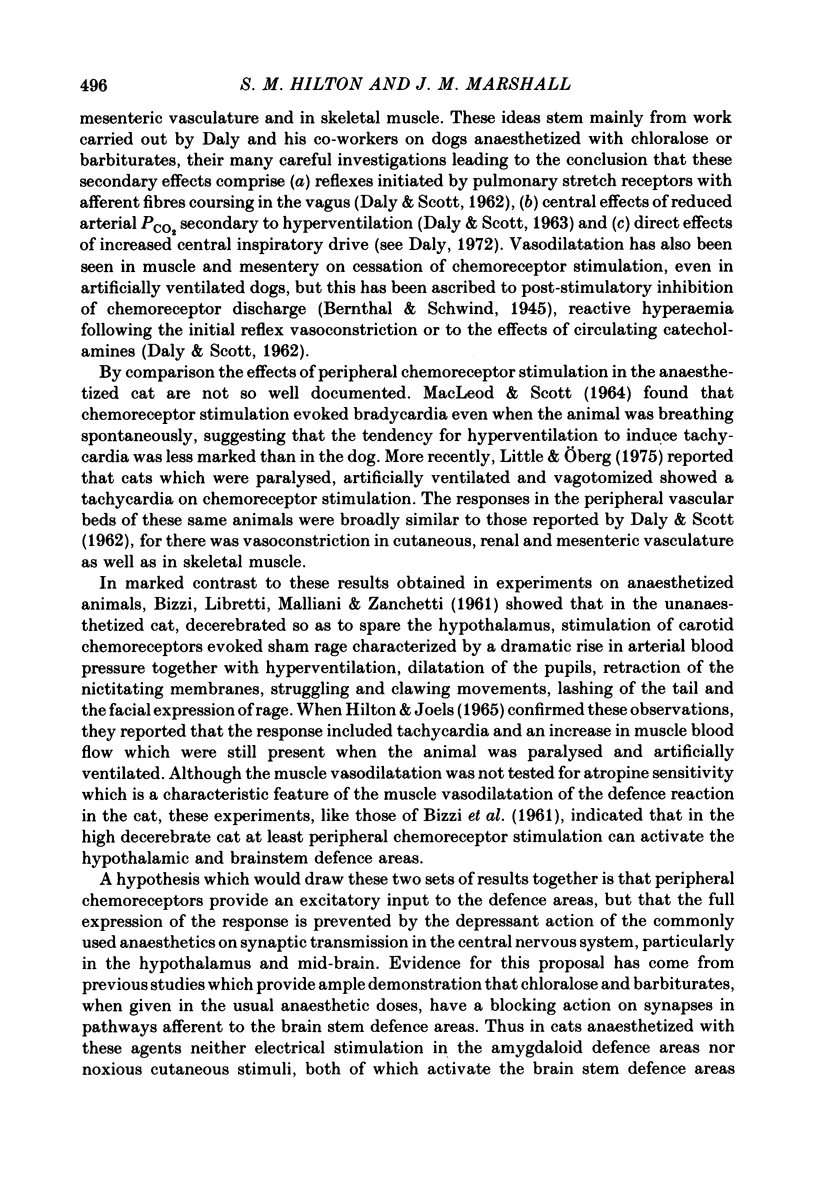
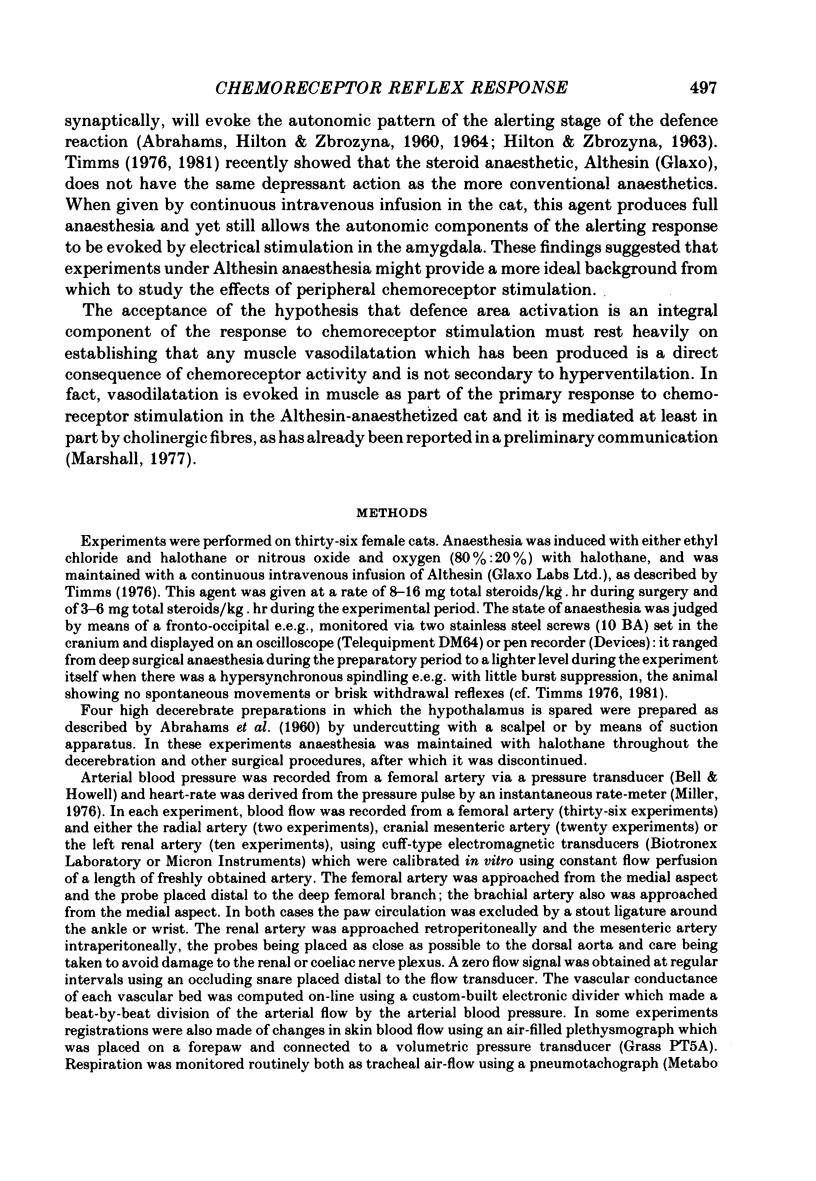

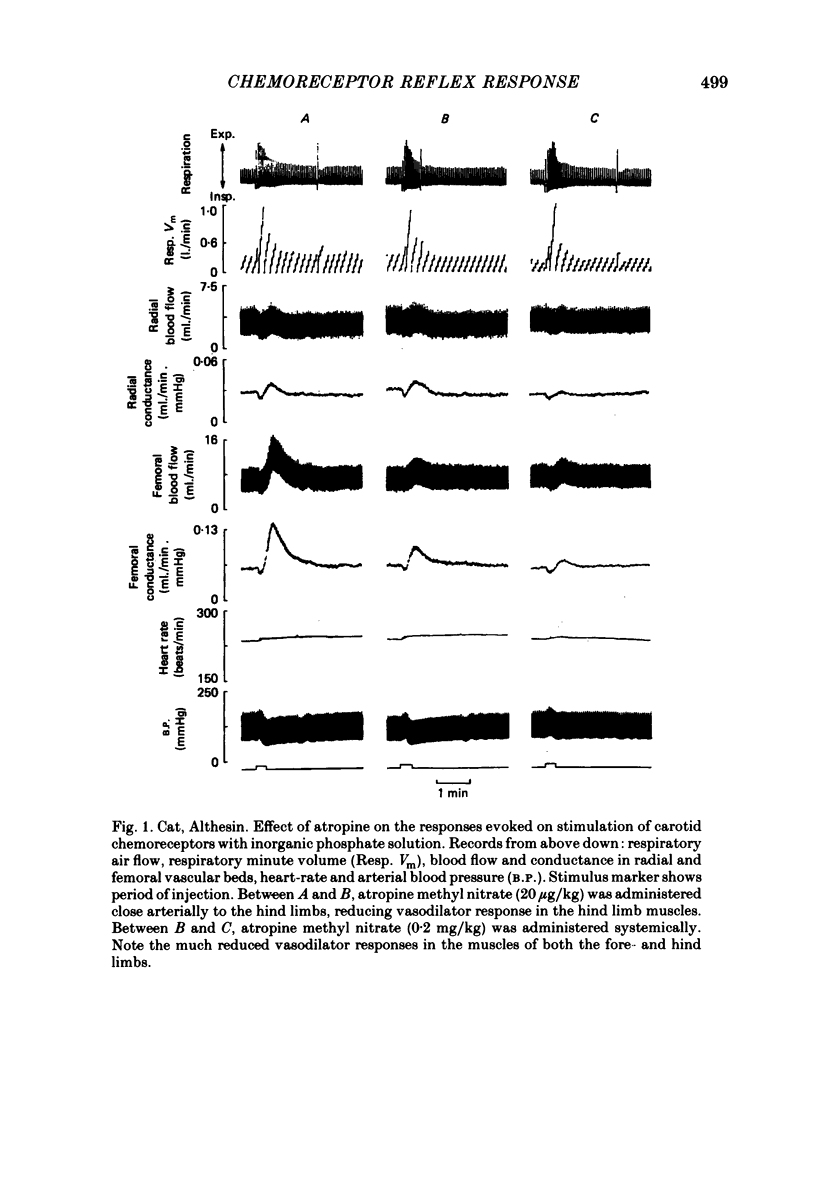
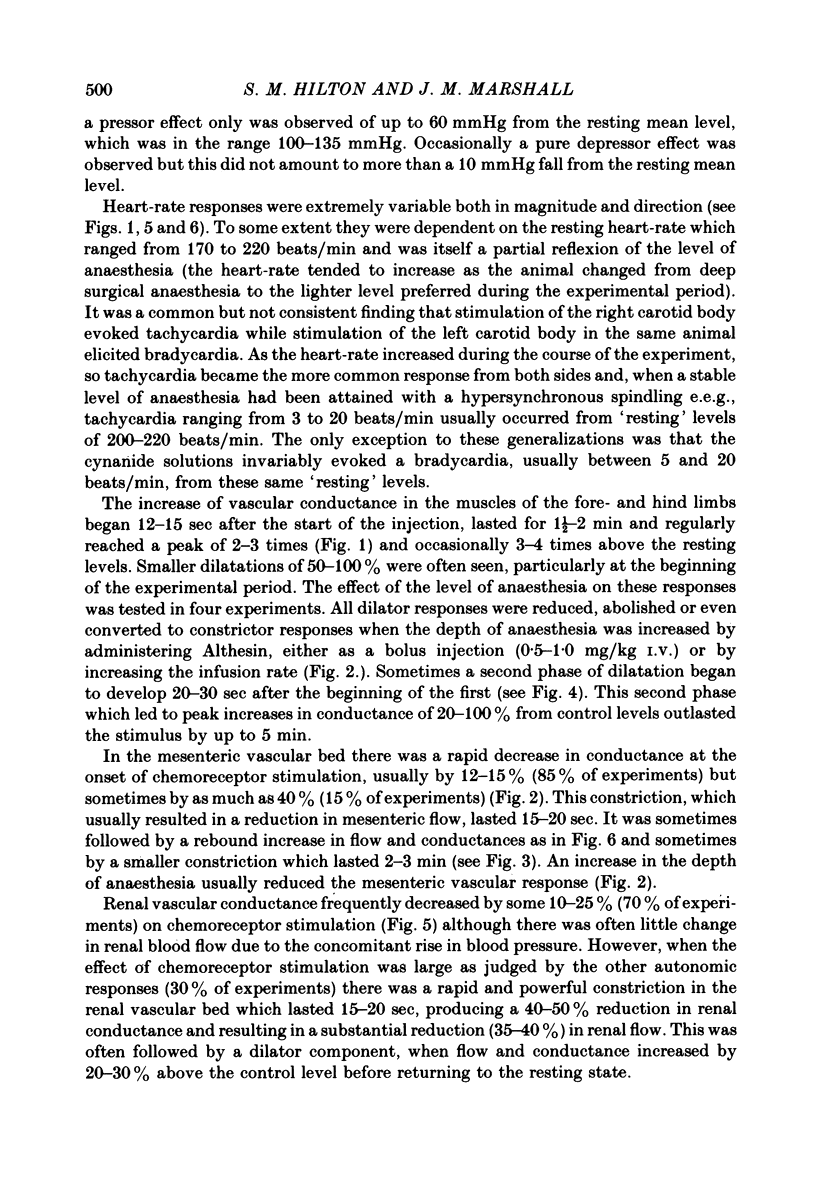
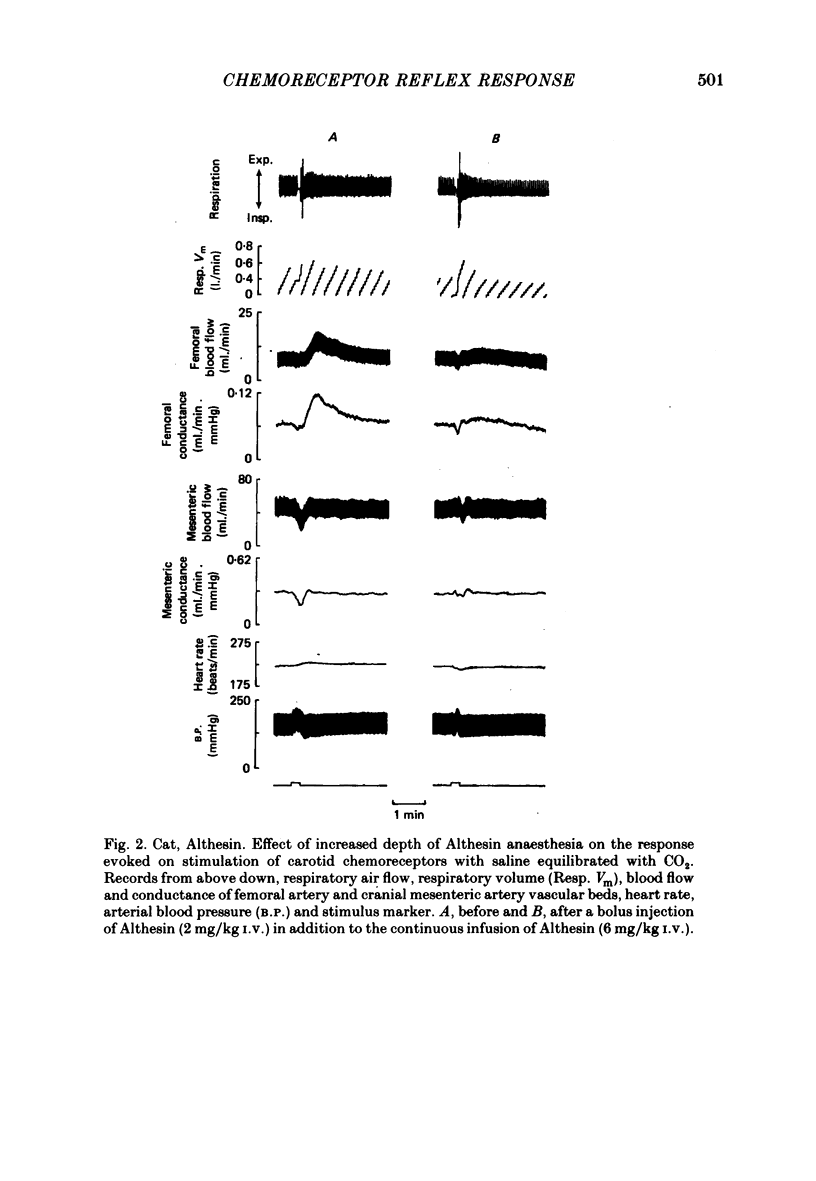
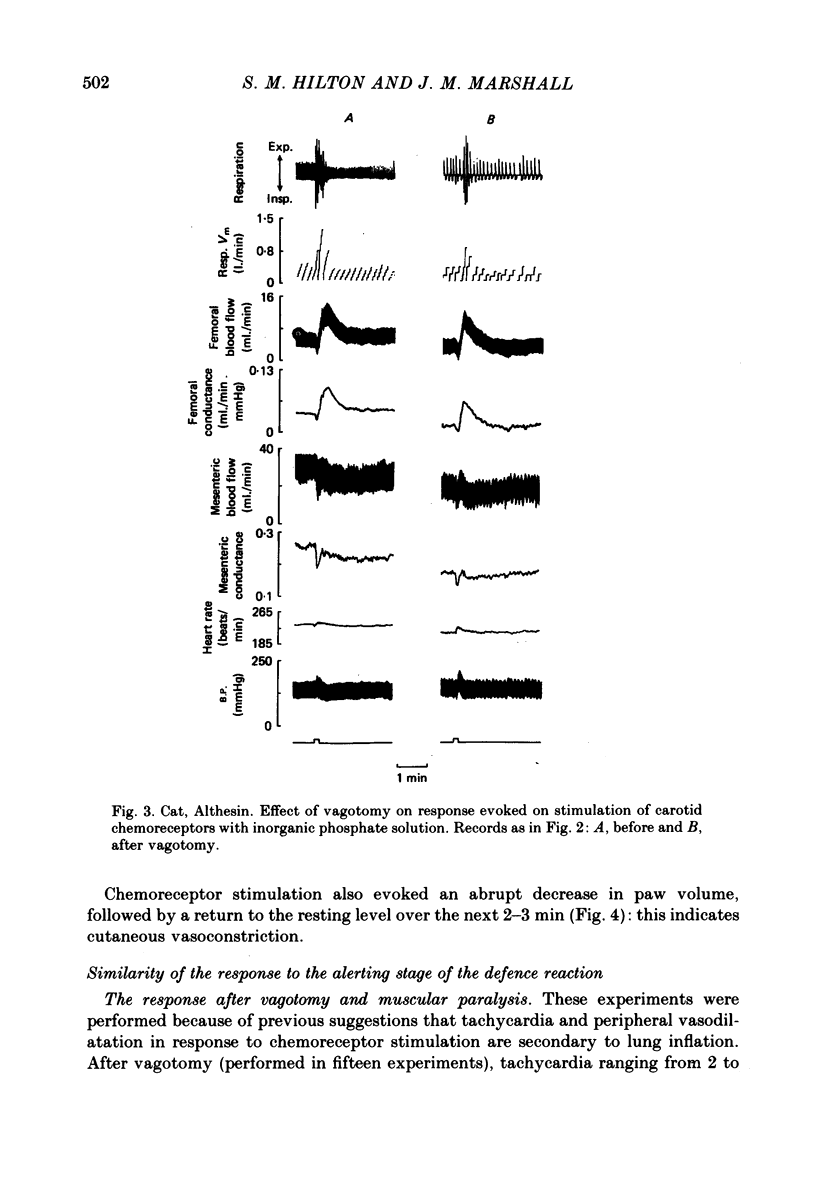


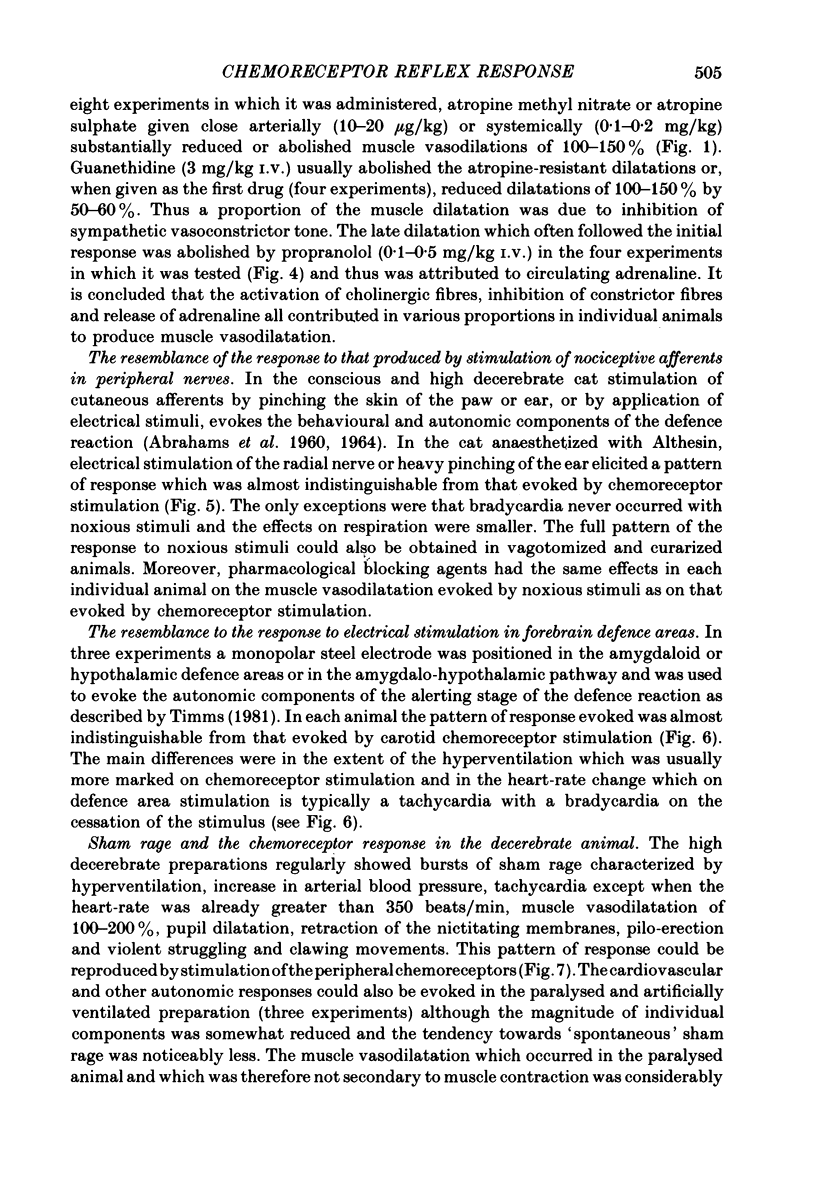
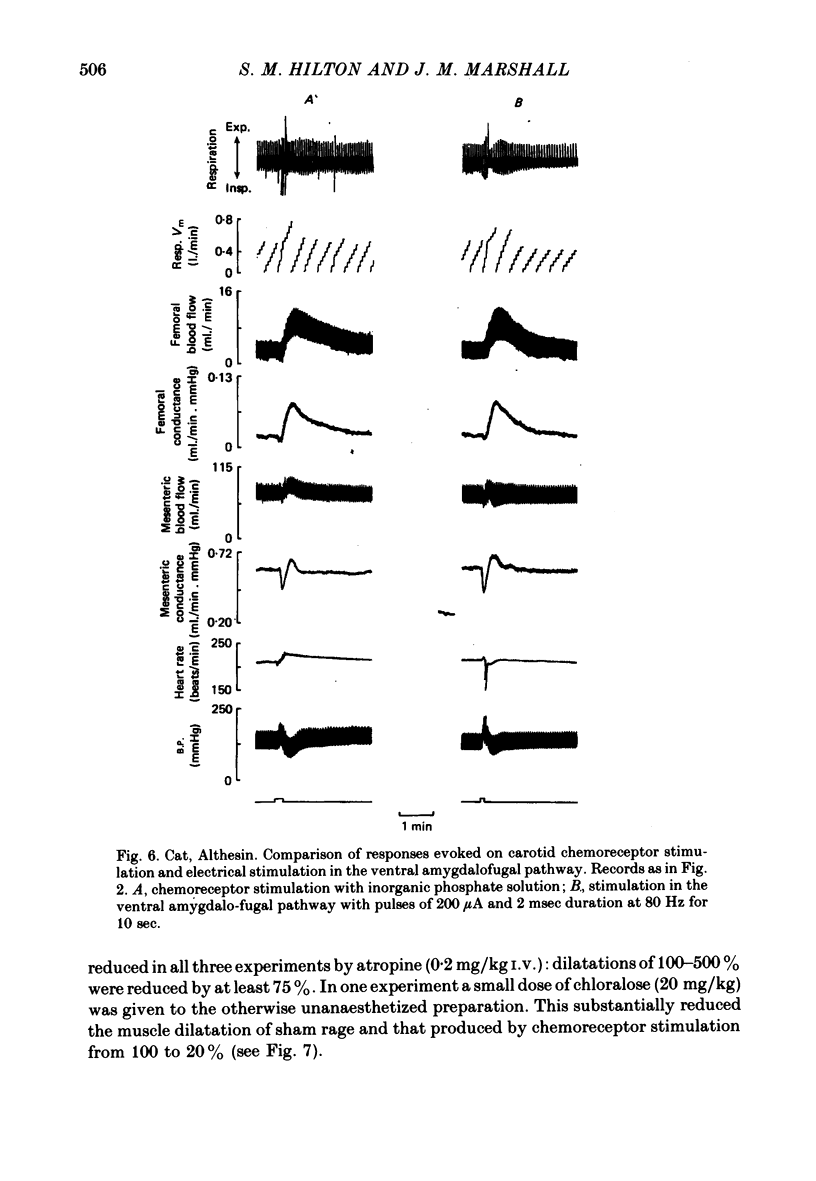
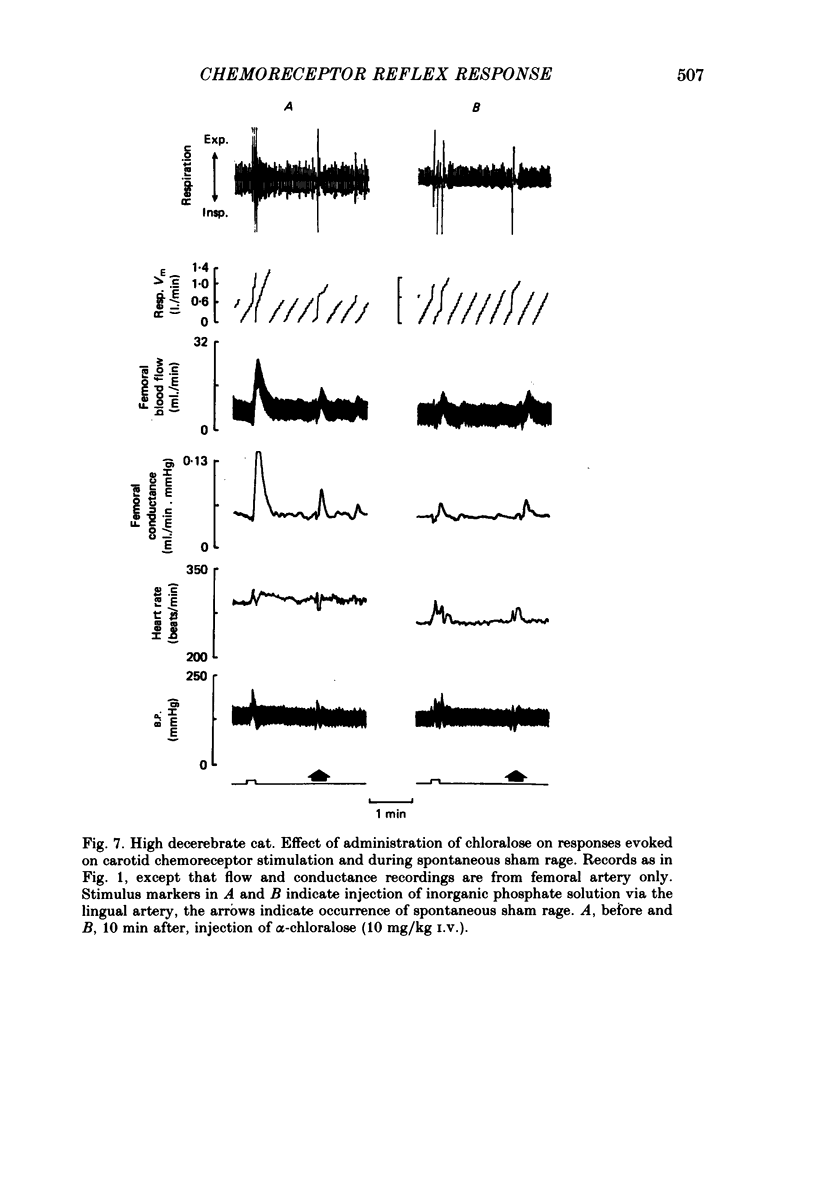
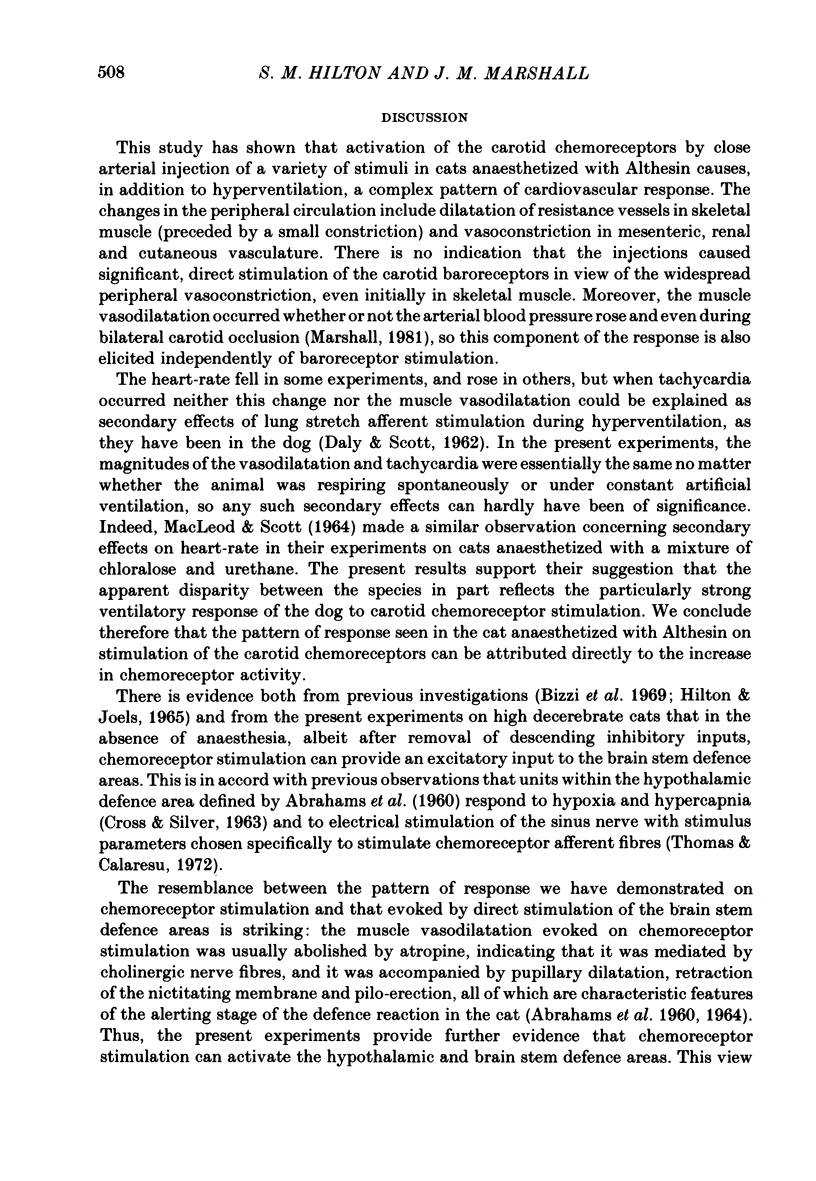
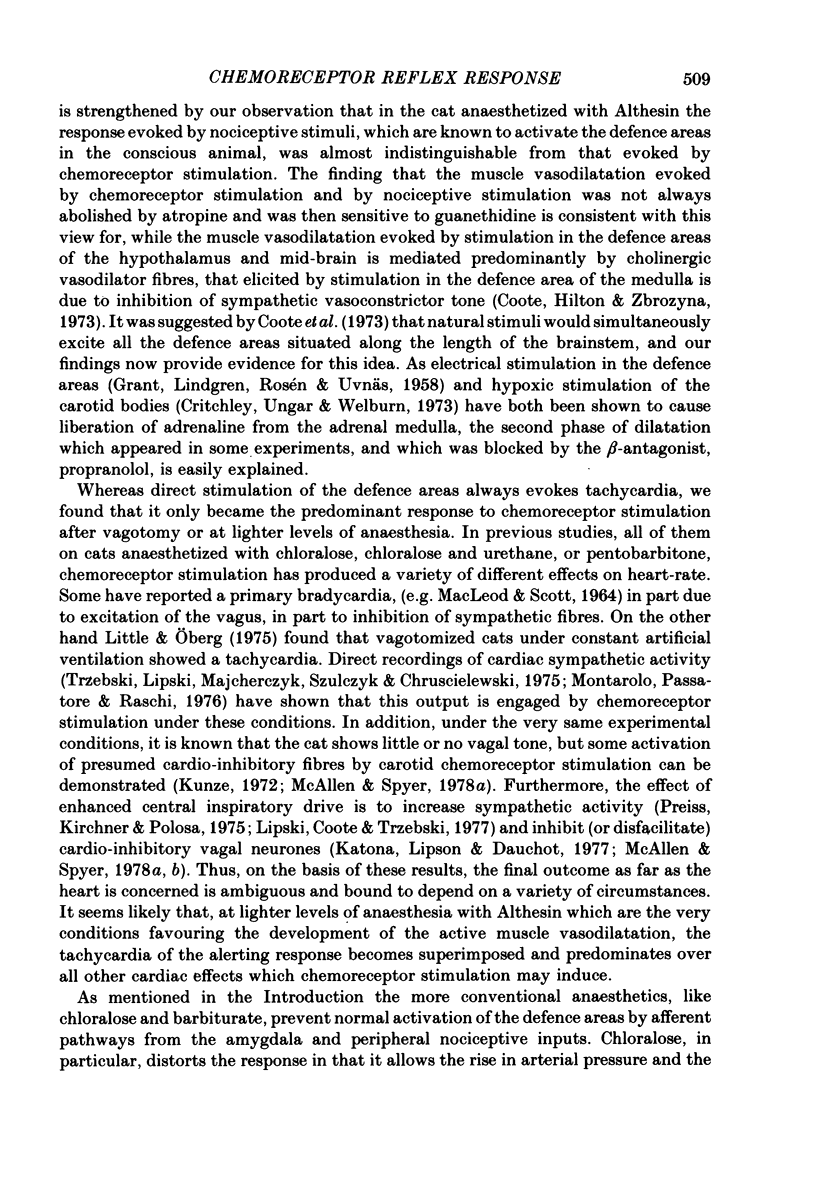
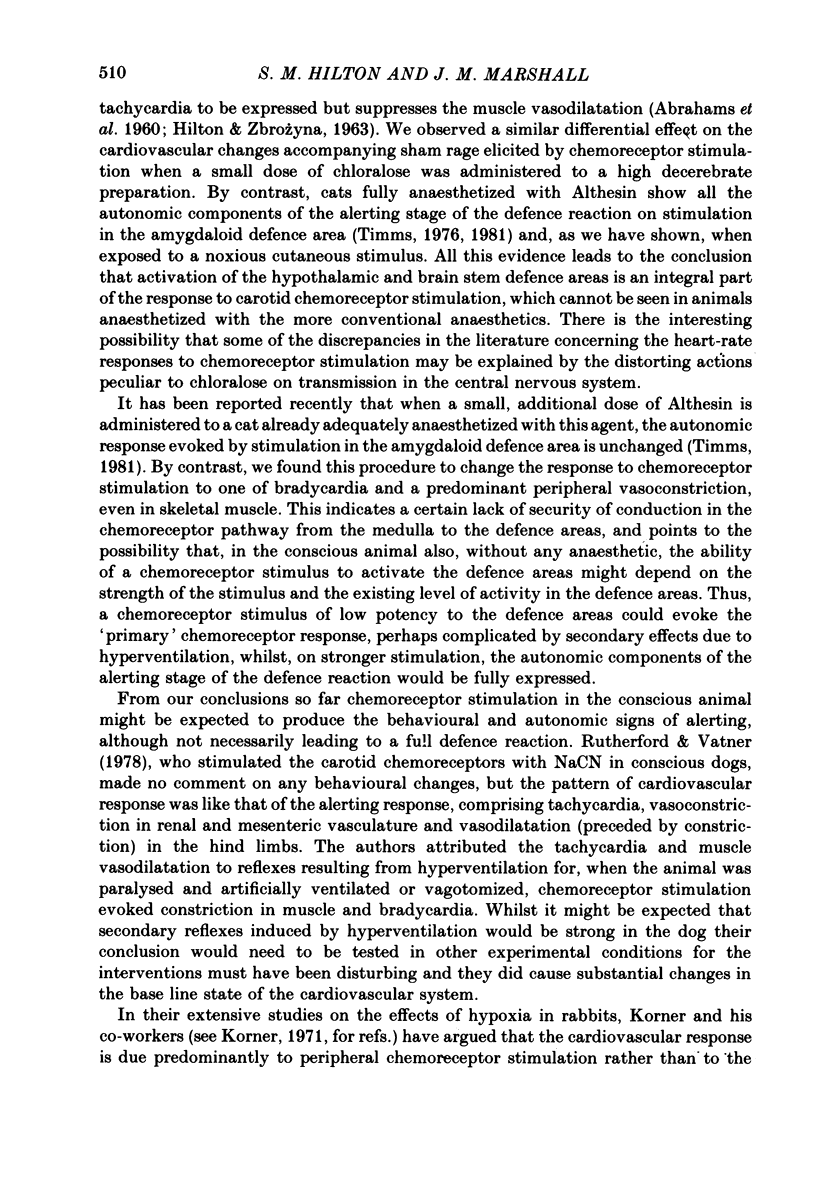

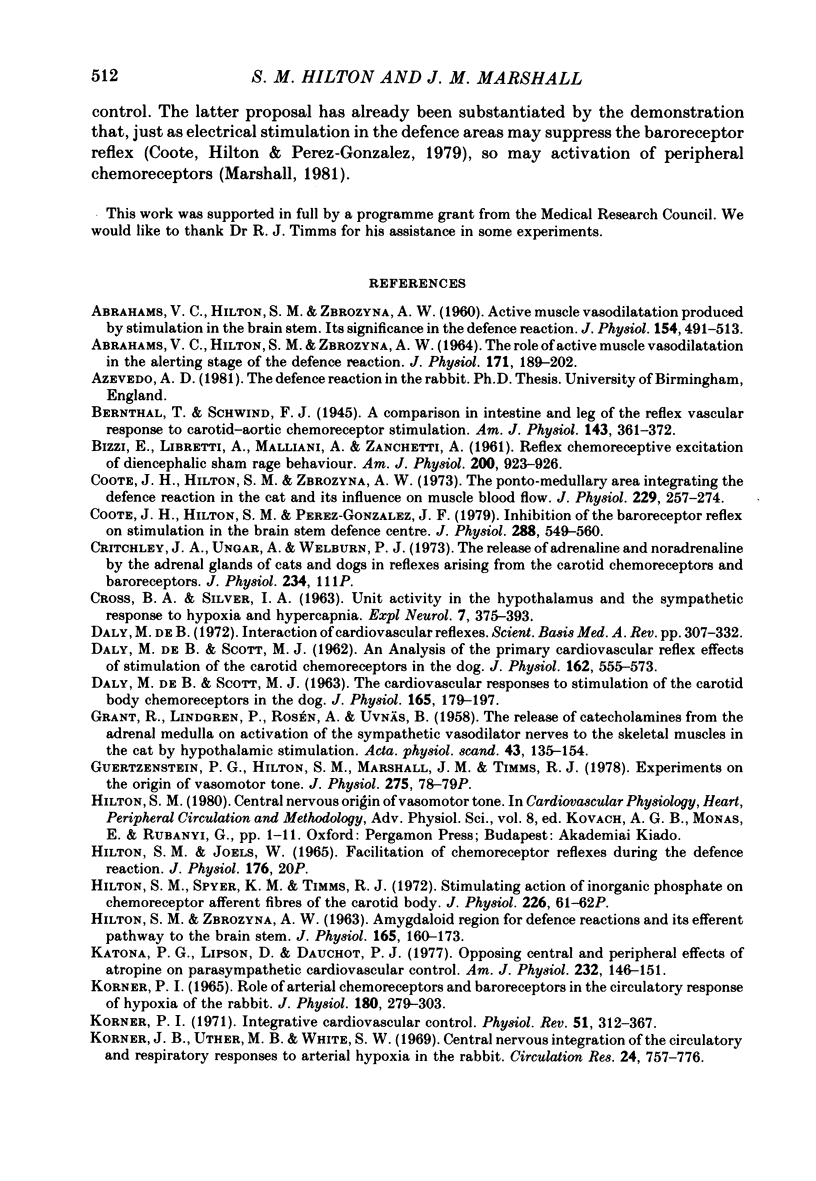

Selected References
These references are in PubMed. This may not be the complete list of references from this article.
- ABRAHAMS V. C., HILTON S. M. THE ROLE OF ACTIVE MUSCLE VASODILATATION IN THE ALERTING STAGE OF THE DEFENCE REACTION. J Physiol. 1964 Jun;171:189–202. doi: 10.1113/jphysiol.1964.sp007371. [DOI] [PMC free article] [PubMed] [Google Scholar]
- ABRAHAMS V. C., HILTON S. M., ZBROZYNA A. Active muscle vasodilatation produced by stimulation of the brain stem: its significance in the defence reaction. J Physiol. 1960 Dec;154:491–513. doi: 10.1113/jphysiol.1960.sp006593. [DOI] [PMC free article] [PubMed] [Google Scholar]
- CROSS B. A., SILVER I. A. Unit activity in the hypothalamus and the sympathetic response to hypoxia and hypercapnia. Exp Neurol. 1963 May;7:375–393. doi: 10.1016/0014-4886(63)90019-0. [DOI] [PubMed] [Google Scholar]
- Coote J. H., Hilton S. M., Perez-Gonzalez J. F. Inhibition of the baroreceptor reflex on stimulation in the brain stem defence centre. J Physiol. 1979 Mar;288:549–560. [PMC free article] [PubMed] [Google Scholar]
- Coote J. H., Hilton S. M., Zbrozyna A. W. The ponto-medullary area integrating the defence reaction in the cat and its influence on muscle blood flow. J Physiol. 1973 Mar;229(2):257–274. doi: 10.1113/jphysiol.1973.sp010137. [DOI] [PMC free article] [PubMed] [Google Scholar]
- DALY M. D., SCOTT M. J. The cardiovascular responses to stimulation of the carotid body chemoreceptors in the dog. J Physiol. 1963 Jan;165:179–197. doi: 10.1113/jphysiol.1963.sp007051. [DOI] [PMC free article] [PubMed] [Google Scholar]
- DE BURGH DALY M., SCOTT M. J. An analysis of the primary cardiovascular reflex effects of stimulation of the carotid body chemoreceptors in the dog. J Physiol. 1962 Aug;162:555–573. doi: 10.1113/jphysiol.1962.sp006950. [DOI] [PMC free article] [PubMed] [Google Scholar]
- GRANT R., LINDGREN P., ROSEN A., UVNAS B. The release of catechols from the adrenal medulla on activation of the sympathetic vasodilator nerves to the skeletal muscles in the cat by hypothalamic stimulation. Acta Physiol Scand. 1958 Aug 25;43(2):135–154. doi: 10.1111/j.1748-1716.1958.tb01583.x. [DOI] [PubMed] [Google Scholar]
- Guertzenstein P. G., Hilton S. M., Marshall J. M., Timms R. J. Experiments on the origin of vasomotor tone [proceedings]. J Physiol. 1978 Feb;275:78P–79P. [PubMed] [Google Scholar]
- HILTON S. M., ZBROZYNA A. W. Amygdaloid region for defence reactions and its efferent pathway to the brain stem. J Physiol. 1963 Jan;165:160–173. doi: 10.1113/jphysiol.1963.sp007049. [DOI] [PMC free article] [PubMed] [Google Scholar]
- Hilton S. M., Spyer K. M., Timms R. J. Stimulating action of inorganic phosphate on chemoreceptor afferent fibres of the carotid body. J Physiol. 1972 Oct;226(2):61P–62P. [PubMed] [Google Scholar]
- Korner P. I. Integrative neural cardiovascular control. Physiol Rev. 1971 Apr;51(2):312–367. doi: 10.1152/physrev.1971.51.2.312. [DOI] [PubMed] [Google Scholar]
- Korner P. I. The role of the arterial chemoreceptors and baroreceptors in the circulatory response to hypoxia of the rabbit. J Physiol. 1965 Sep;180(2):279–303. doi: 10.1113/jphysiol.1965.sp007703. [DOI] [PMC free article] [PubMed] [Google Scholar]
- Korner P. I., Uther J. B., White S. W. Central nervous integration of the circulatory and respiratory responses to arterial hypoxemia in the rabbit. Circ Res. 1969 Jun;24(6):757–776. doi: 10.1161/01.res.24.6.757. [DOI] [PubMed] [Google Scholar]
- Kunze D. L. Reflex discharge patterns of cardiac vagal efferent fibres. J Physiol. 1972 Apr;222(1):1–15. doi: 10.1113/jphysiol.1972.sp009784. [DOI] [PMC free article] [PubMed] [Google Scholar]
- Lipski J., Coote J. H., Trzebski A. Temporal patterns of antidromic invasion latencies of sympathetic preganglionic neurons related to central inspiratory activity and pulmonary stretch receptor reflex. Brain Res. 1977 Oct 21;135(1):162–166. doi: 10.1016/0006-8993(77)91061-7. [DOI] [PubMed] [Google Scholar]
- Little R., Oberg B. Circulatory responses to stimulation of the carotid body chemoreceptors in the cat. Acta Physiol Scand. 1975 Jan;93(1):34–50. doi: 10.1111/j.1748-1716.1975.tb05788.x. [DOI] [PubMed] [Google Scholar]
- MACLEOD R. D., SCOTT M. J. THE HEART RATE RESPONSES TO CAROTID BODY CHEMORECEPTOR STIMULATION IN THE CAT. J Physiol. 1964 Dec;175:193–202. doi: 10.1113/jphysiol.1964.sp007511. [DOI] [PMC free article] [PubMed] [Google Scholar]
- Marshall J. M. Interaction between the responses to stimulation of peripheral chemoreceptors and baroreceptors: the importance of chemoreceptor activation of the defence areas. J Auton Nerv Syst. 1981 Apr;3(2-4):389–400. doi: 10.1016/0165-1838(81)90077-1. [DOI] [PubMed] [Google Scholar]
- Marshall J. M. The cardiovascular response to stimulation of carotid chemoreceptors [proceedings]. J Physiol. 1977 Mar;266(1):48P–49P. [PubMed] [Google Scholar]
- McAllen R. M., Spyer K. M. The baroreceptor input to cardiac vagal motoneurones. J Physiol. 1978 Sep;282:365–374. doi: 10.1113/jphysiol.1978.sp012469. [DOI] [PMC free article] [PubMed] [Google Scholar]
- McAllen R. M., Spyer K. M. Two types of vagal preganglionic motoneurones projecting to the heart and lungs. J Physiol. 1978 Sep;282:353–364. doi: 10.1113/jphysiol.1978.sp012468. [DOI] [PMC free article] [PubMed] [Google Scholar]
- Montarolo P. G., Passatore M., Raschi F. Carotid chemoreceptor influence on the cardiac sympathetic nerve discharge. Experientia. 1976 Apr 15;32(4):480–481. doi: 10.1007/BF01920808. [DOI] [PubMed] [Google Scholar]
- Preiss G., Kirchner F., Polosa C. Patterning of sympathetic preganglionic neuron firing by the central respiratory drive. Brain Res. 1975 Apr 11;87(2-3):363–374. doi: 10.1016/0006-8993(75)90434-5. [DOI] [PubMed] [Google Scholar]
- Rutherford J. D., Vatner S. F. Integrated carotid chemoreceptor and pulmonary inflation reflex control of peripheral vasoactivity in conscious dogs. Circ Res. 1978 Aug;43(2):200–208. doi: 10.1161/01.res.43.2.200. [DOI] [PubMed] [Google Scholar]
- Thomas M. R., Calaresu F. R. Responses of single units in the medial hypothalamus to electrical stimulation of the carotid sinus nerve in the cat. Brain Res. 1972 Sep 15;44(1):49–62. doi: 10.1016/0006-8993(72)90365-4. [DOI] [PubMed] [Google Scholar]
- Timms R. J. A study of the amygdaloid defence reaction showing the value of Althesin anaesthesia in studies of the functions of the fore-brain in cats. Pflugers Arch. 1981 Jul;391(1):49–56. doi: 10.1007/BF00580694. [DOI] [PubMed] [Google Scholar]
- Trzebski A., Lipski J., Majcherczyk S., Szulczyk P., Chruścielewski L. Central organization and interaction of the carotid baroreceptor and chemoreceptor sympathetic reflex. Brain Res. 1975 Apr 11;87(2-3):227–237. doi: 10.1016/0006-8993(75)90420-5. [DOI] [PubMed] [Google Scholar]
- Uther J. B., Hunyor S. N., Shaw J., Korner P. I. Bulbar and suprabulbar control of the cardiovascular autonomic effects during arterial hypoxia in the rabbit. Circ Res. 1970 Apr;26(4):491–506. doi: 10.1161/01.res.26.4.491. [DOI] [PubMed] [Google Scholar]
- de Burgh Daly M. Interaction of cardiovascular reflexes. Sci Basis Med Annu Rev. 1972:307–332. [PubMed] [Google Scholar]


